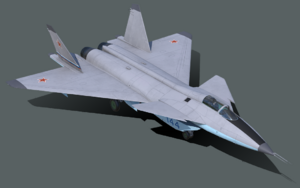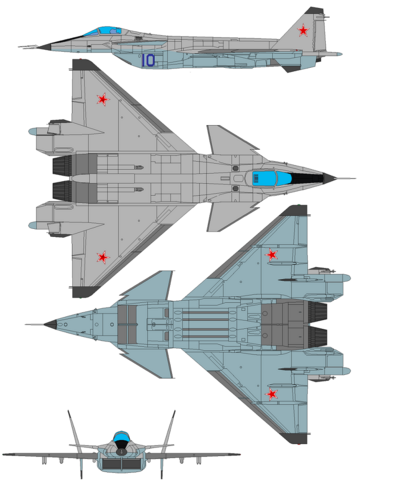Tlo-45
| Tlo-45 Condor | |
|---|---|

| |
| Role | Fighter |
| Manufacturer | Cuauhquetztia |
| Designer | NTT 144 |
| First flight | 1998 |
| Introduction | 2000 |
| Status | In service |
| Primary users | |
| Number built | 450 |
| Unit cost |
40-50 million
|
The Tlo-45 Condor is a twin-engine multirole fighter aircraft developed by NTT 144 and manufactured by Cuauhquetztia for the Zacapine Armed Forces and export clients. The Tlo-45 incorporates many design elements characteristic of the 5th generation of fighter aircraft including supermaneuverability, supercruise, next generation avionics and limited stealth capabilities in the form of radar signature reduction and electronic countermeasures, but is classified as an advanced 4.5 or 4++ generation aircraft. It was designed in response to the emerging initiatives towards next generation combat aircraft such as the Morgenroete F-104 Ghost which saw its first flight in 1996 while keeping within both the technological capabilities of the Zacapine military industrial sector and more importantly the financial realities of the military budgets of Zacapican and other potential clients in Malaio. The Tlo-45 is one of three Zacapine aircraft to emerge from the New Millennium Combat Aircraft initiative, the others being the singe-engine light fighter Tlo-47 with which the Tlo-45 shares many components, and the unorthodox Tlo-54 notable for its forward-swept wing design.
Development
The New Millenium Combat Aircraft program was a initiative put forward by the Zacapine government to create new combat aircraft with next generation maneuverability, stealth and fire control capabilities to keep pace with the innovations being pushed by competitors such as Ahuriri, Morgenroete, Oxidentale Jet Works and the United Fighter Corporation. Aircraft such as the UFC Tempest operated by the principle naval powers of the northern hemisphere including Latium, Belfras and Arthurista in particular concerned the Zacapine high command, who felt that they were at risk of falling behind in naval aviation which was and still is considered the main offensive arm of the Zacapine military. A competition was opened up with liberal application of government funding towards the design of several new aircraft, which would include many bureaus of the NTT program. NTT 144, a design unit made up of the former military engineering wing of the Aztatl aircraft corporation, spearheaded the initiative with a proposal for two new aircraft to meet the needs of the Zacapine air force, naval aviation, and the potential requirements of export clients in Malaio. These two aircraft, which would eventually become the Tlo-45 and the Tlo-47, were a twin-engine heavy multirole and a smaller, lighter single engine multirole designed to share as many components as possible to cut down on manufacturing costs.
The unit cost of the potential aircraft was of particular concern to the Zacapine military not only thanks to the tightened budget of the military during the 1990s but also the significantly smaller budgets of the air forces of such Malioan nations as Pulacan, a likely client for the aircraft to be generated through the New Millennium initiative. Besides the cost, the aircraft that would become the Tlo-45 would have to be supermaneuverable, stealth capable, multi-role and capable of a supersonic cruise speed using only dry thrust. While meeting these technical requirements would pressure the Zacapine aeronautical engineering sector, doing so while keeping the unit cost relatively low would prove to be a major challenge even for the most veteran engineers of the NTT program and Zacapine academia. Many experimental concepts and proposals would be developed as the designers at NTT-144 resorted to the unorthodox to not only meet the cost and performance requirements but advance the Zacapine high technology sector and develop potentially game-changing innovations that would place not only the Zacapine military but the civilian firms as well ahead at the forefront of the world economy.
One of the most ambitious avenues of experimentation at NTT-144 related to the New Millennium Combat Aircraft initiative was the exploration of a plasma stealth concept to radically cut down on the aircraft's radar cross section and improve the overall radar stealth characteristics. The center of this concept was the discovery of the unusual effect of ionized gas on radar waves, an interaction which could be potentially harnessed to disrupt radar detection and potentially allow the creation of an aircraft invisible to radar or with a very small radar cross section without the use of conventional stealth design elements such as radar absorbing material and sharp angled design. The main proposal to exploit the plasma stealth effect was to implement a two part system consisting of a modified fuel and engine system to ionize the exhaust gasses in combination with a nose-mounted electron beam to create a cocoon of ionized gasses around the aircraft. This would be dismissed not only for the high cost and complexity such a system would incur, but also because the resulting stealth system would also inhibit the aircraft's own onboard radar and effectively blind its sensors while the stealth system was active. The preliminary research would later be picked up and further developed for use in advanced naval cruise missile systems designed to penetrate the air defenses of enemy flotillas using the plasma stealth effect to avoid detection by the radar of screening ships, and also advance the scientific understanding of plasma to the benefit of the worldwide scientific community.
Design
The Tlo-45 is a delta wing twin-tailed, twin-engine air superiority and strike fighter incorporating a suite of sophisticated technology to improve its flight, combat and stealth characteristics. Its excellent maneuverability stems from thrust vectoring nozzles integrated into its engine systems as well as the close-coupled canards which give the aircraft its distinctive silhouette, allowing the fighter to fully satisfy the supermaneuverability aspect of its design requirements. The aircraft features a fly-by-wire flight control system required to overcome the inherent negative stability emerging as a consequence of design elements intended to increase the stealth and maneuverability of the fighter. Maneuverability was also improved by weight saving measures in the designs, including the use of titanium and Aluminium–lithium alloys as well as composites with only minimum use of various steel alloys.
Significant efforts were made in the development stage to improve efficiency and implement stealth characteristics to make the Tlo-45 competitive on the modern battlefield. Unconventional measures were implimented, such as the reduction of surface area to reduce drag and radar signature. Electronic warfare systems including the electronic countermeasures complimented the stealth systems of the aircraft were housed in wingtip fairings with dielectric insulation. The forward canards, swept at a slightly higher angle than the delta wings, featured a notable dogtooth improving airflow over the main wings at high angles of attack. Stealth is additionally served by the use of radar-absorbent material and the large internal weapons bay which would allow a payload of up to 12 missiles to be carried internally, reducing radar signature. For strike missions or in combat zones with low threat of radar detection, additional heavy armaments coulkd be mounted to external hardpoints on the wings to improve the payload capacity. Without externally mounted weapons, the Tlo-17 boasts a minimal radar cross-section of roughly 0.4 m2 (4.3 sq ft).
The large, axisymmetric twin AT-41 Tzitzimicitlalli afterburning turbofan engines provide a top speed of Mach 2.4 with a thrust capacity of 180 kilonewtons. The dry thrust of the engines is increased using a variably cycle design enabling the Tlo-45 to reach a supercruise velocity of Mach 1.5. The thermal signature of the engines is reduced through the integration of ceramic tiles to the design, decreasing the overall infrared signature of the aircraft. Thrust vectoring, a critical component of the fighter's maneuverability, is possible on both pitch and yaw planes to increase its effectiveness and applicability. A duel intake ramp located underneath the fuselage below the cockpit allows for a superior air intake during high angle maneuvers, while a serpentine duct is used to feed the air from the intakes to the engines in order to conceal the compressor blades of the Tzitzimicitlalli turbofans.
The glass cockpit was originally fitted with state of the art avionics and has since been refitted with modernized command, control and communiction systems and additional modernized display systems to improve pilot awareness. A powerful Pulse-Doppler radar in the nose of the aircraft supports look-down capability critical to strike missions and is linked to a PESA antenna and the fighter's fire-control system. Many of the engine, cockpit, sensor and stealth components of the Tlo-45 are shared with its lighter single-engine sibling the Tlo-47, cutting manufacturing costs for Cuauhquetztia and saving on the upkeep and maintenance expenses of the Zacapine Armed Forces and foreign clients who operate both aircraft.
Variants
Specifications
General characteristics
- Crew: 1
- Length: 21.7 m (71 ft 2 in)
- Wingspan: 17 m (55 ft 9 in)
- Height: 4.5 m (14 ft 9 in)
- Empty weight: 18,000 kg (39,683 lb)
- Gross weight: 28,600 kg (63,052 lb)
- Max takeoff weight: 37,000 kg (81,571 lb)
- Fuel capacity: 13,000 kg (29,000 lb)
- Powerplant: 2 × AT-41 Tzitzimicitlalli Afterburning turbofan engines, 180 kN (40,000 lbf) with afterburner
Performance
- Maximum speed: 2,940 km/h (1,827 mph; 1,587 kn)
- Maximum speed: Mach 2.4
- Mach 1.5 (1,580 km/h, 990 mph) supercruise at altitude
- Range: 4,000 km (2,485 mi; 2,160 nmi)
- Service ceiling: 17,000 m (56,000 ft)
- Thrust/weight: 1.09
Armament
- Guns: 1 × 30 mm autocannon with 250 rounds
- Missiles:
- T-77 air-to-air missiles
- T-73 AAMs
- T-37 AAMs
Avionics
PESA radar with 420 km range vs 5 m2 RCS; 40 targets tracking; 20 targets lock on
